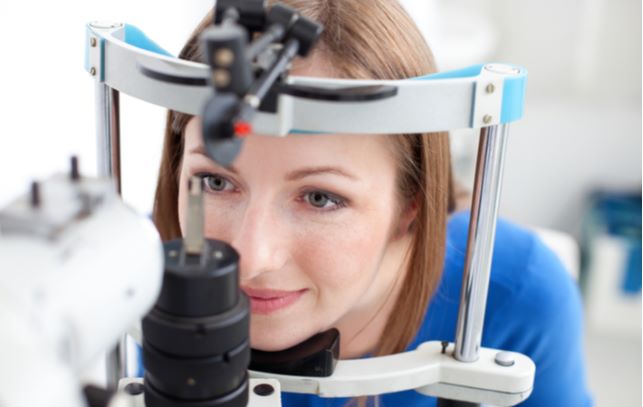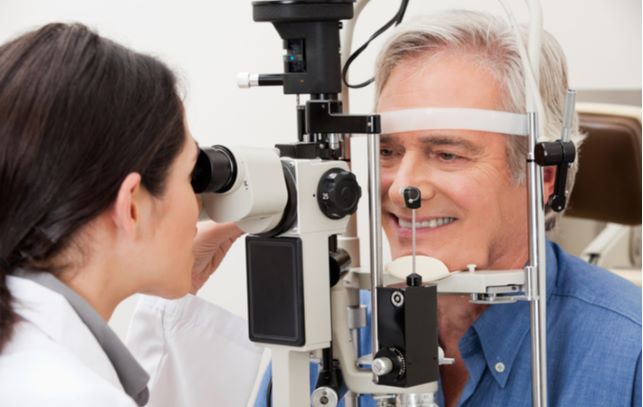Many different types of health conditions can cause vision changes or loss. It can be sudden and immediately noticeable, but it can also happen gradually, which may make it harder for you to detect. This is why your optometrist may suggest a visual field test after conducting a regular comprehensive eye exam. Your eye doctor may be able to notice blind spots in your visual field that you haven’t noticed.
If you think you are experiencing vision loss, contact us to book an appointment —our team at River Heights Eye Care is always here to help you.
Why Do I Need a Visual Field Test?
Eye care professionals perform visual field tests during a comprehensive eye exam to detect issues in your visual field.
Your visual field covers everything you can see when you’re focusing on a central point. Your eye doctor can measure how far the eye sees and how sensitive the vision is in different parts of your visual field by assessing your visual field. This helps doctors identify certain types of conditions and diseases.
As mentioned earlier, you may not be aware of blind spots in your vision and can easily miss the signs. By receiving regular eye exams, you can be confident that your eye doctor can see the signs of developing eye diseases, helping you get effective treatment as early as possible.
To protect your vision and overall health, book an eye exam today.
Symptoms of Vision Loss
There are several symptoms you may notice that could mean you are losing your sight. Some of these symptoms come on gradually, and some can appear suddenly. If you are experiencing any of the following symptoms, contact your eye doctor:
- Double vision, blurry vision, or tunnel vision
- Seeing flashes of light or halos around lights
- Seeing floaters or “spider webs”
- Seeing a “curtain” coming down over one eye
- A sudden decrease in vision
- Sensitivity to light and glare
- Eye pain, redness, or swelling
- Itching or burning eyes
- Tripping, falling, or an increase in clumsiness
- Difficulty driving or moving in the dark
While it’s common to have some symptoms of vision loss, you may not experience any symptoms at all.
What Can a Visual Field Test Detect?
A visual field test can detect areas of vision loss caused by several health conditions, including:
- Glaucoma
- Diabetes
- Brain tumor
- Stroke
- Hypertension
- Head trauma

The 6 Types of Visual Field Tests
There are many different types of visual field tests your optometrist may use.
1. Confrontation Visual Field Test
A confrontation visual field test is a screening test performed by your optometrist during your regular eye exam. During this test, your doctor will ask you to focus on an object in front of you and test how well you can see objects in your peripheral vision. If your doctor notices any abnormalities during a confrontation visual field, they may perform additional visual field tests.
2. Automated Static Perimetry Test
If you need a more specific test to monitor the progression of an eye disease, your eye doctor may use an automated static perimetry test. This test uses an instrument called a perimeter that flashes lights around your visual field. Then, when you see the light, you press a button, helping your doctor create a detailed map of where you can and can’t see.
3. Kinetic Visual Field Test
A kinetic visual field test is similar to an automated static perimetry test, but instead of flashing lights, it uses moving light targets to test your vision.
4. Frequency Doubling Perimetry Test
Another way your doctor can assess your visual field is through a test called frequency doubling perimetry. This test uses a flickering optical illusion to check for damage to vision. The illusion uses vertical bars and can show vision loss if you’re unable to see the vertical bars at certain times during the test.
5. Electroretinography Test
Electroretinography is a test that can determine vision loss caused by certain retina conditions. This test is similar to an automated static perimetry test, but it uses electrodes to measure the electrical signals of the cells in the retina to see how your eyes respond to flashes of light.
6. Amsler Grid Test
The Amsler grid test is a visual field test specifically for people with age-related macular degeneration (AMD). This test uses a grid pattern with a dot in the middle. Your eye doctor will ask you to describe the image and describe any areas that may appear wavy, blurry, or blank.
While this test only measures the middle of the visual field, it is still an effective tool to test your overall vision.
How Often Should I Get my Eyes Checked
We recommend you get an eye exam at least once every 1-2 years to keep your eyes healthy and seeing well, depending on your age and overall health. In addition to your regularly scheduled eye exams, you may need to see your optometrist if you are experiencing any vision issues, symptoms, or injuries.
If you have any questions or concerns about your eye health, book an appointment with us today!


